SIDO Lyon 2024
18-19 SeptemberLyon, France
Expo
A Tele2 IoT White Paper
Electric vehicles (EVs) have entered the mainstream, with most major car manufacturers joining early pioneers like Tesla in offering EV or hybrid options. This is leading to an explosion in EV car sales, particularly across Europe – and as sales of EVs continue to skyrocket, an evolving Electric Vehicle (EV) Ecosystem is swiftly emerging. In order to connect, maintain, and manage the different parts of the EV ecosystem there is a strong need for resilient and two-way connectivity. In other words, IoT technology and cellular connectivity will be critical to the growth and long term viability of the EV market.
A great charging experience starts with working chargers, dependable authentication, usage metering, and payment, along with a mobile app that shows charger location, real-time availability, and even dynamic pricing and SMS alerts on charging status (e.g., charging, 80% charged, 10 minutes remaining, charging complete) while the customer enjoys a coffee next door.
The EV charging picture of the future will transform the 30-minute ho-hum charging experience into something drivers actually enjoy.
The charging station can provide a Wi-Fi hotspot for customers to work or watch the news from their car or feature interactive digital displays to learn about local attractions, which will be a source of advertising revenue for the station operator. There can also be a service to update the vehicle’s software while it charges. And as private chargers are outnumbering public ones, for companies installing private chargers at home, the ability to make software changes is important to maintain a great customer experience.
Some companies are bringing together hundreds of different CPOs, apps, and payment solutions under one umbrella, giving customers a one-stop-shop experience, even across borders.
Underpinning all of these customer experiences—both today and tomorrow—is a reliable, secure network. Cellular networks are often more practical than wired networks for charging stations because they avoid the expense of wiring, as well as the cost and disruption that occurs when there is a need to change the infrastructure. Cellular connectivity reaches virtually everywhere, including highway service areas and remote locations. Connecting a new charger to the cellular network can be as simple as inserting a SIM card. And many locations are served by multiple cellular networks, providing resilience if one network has an issue, something that can be a challenge in more remote areas.
The EV ecosystem is every part of the system that makes electric vehicles commercially viable. While cars and charging stations are what first come to mind when we talk about EVs and the ecosystem around them, in terms of vehicles and even charging stations, there’s a lot more going on. EVs can mean boats, motorcycles, mopeds, e-scooters, e-bikes, e-cargo bikes, and much more, including autonomous robots used for last-mile delivery. On the charging side, there are the ubiquitous single charging stations, but beyond that we have solutions that range from large-scale charging stations and charging plazas to in-transit charging solutions and portable charging stations. Then we have the used car market, connected infrastructures, communication technologies, value-added services, in-vehicle information, payment solutions, battery management, energy optimization, etc. Cellular connectivity and IoT technology are the crucial components bringing the whole ecosystem together, offering huge benefits to stakeholders across the entire EV value chain.
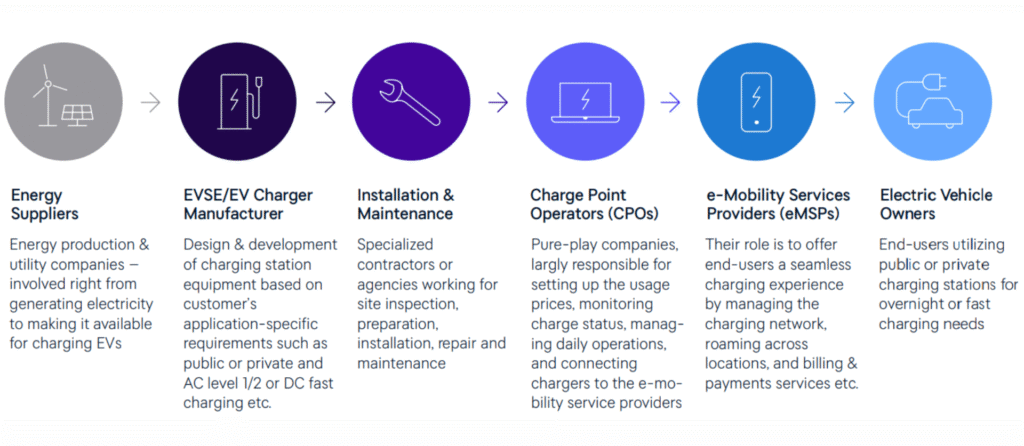
Source: Einfochips
In terms of EV charging, the EV ecosystem consists of a number of different players. Because this market is evolving, with several types of growth developments, these actors are increasingly interacting and overlapping, making it challenging to understand the whole picture. Let’s look at the three main components in the EV ecosystem: charge point operators, mobility service providers, and hardware and software providers.
Charge point operators (CPOs) take one of the central roles in the EV ecosystem. Simply put, CPOs manage networks of connected charging stations using a software platform to make sure all charge points are up and running so that EV drivers can charge their cars without any hassle. There are three different use cases in this area:
A CPO can have considerable impact on the market. First, they can influence the cost of charging hardware by negotiating large volume discounts. The cost of charging hardware has dropped considerably, mainly due to scale caused by the adoption of EV transportation globally.
A CPO can also determine the charging capacity at a charging location. The charging hardware itself has physical limitations by design, but flexibility is available in the platform which allows the CPO to determine different dynamics, including priority or delayed charging and load balancing. By using a software platform to monitor and manage the charging stations as well as a connectivity platform, CPOs are able to maintain their business in an efficient way.
A CPO also defines the base price model of charging at a particular location, which can then be segmented into several components: on-off starting fee, duration or connection fee, and session fee.
Mobility Service Providers (MSPs) provide customers access to networks of charging stations. In real terms, this means they provide charge cards and/or charging apps that allow drivers to locate charging stations, as well as manage and pay for charging. Often, MSPs partner up under ‘roaming agreements,’ which allows them to offer additional charging stations to their customers. Some companies are bringing together hundreds of different CPOs, apps, and payment solutions under one umbrella, giving customers a one-stop-shop experience, even across borders.
MSPs don’t necessarily focus only on EV charging services. Mobility as a Service (MaaS) allows the integration of different mobility services, while software enables planning, booking, and payment functionality for multiple transport modes, including public transport, e-bike sharing, car sharing, e-scooter sharing, etc. This means customers can do everything from knowing when the next train is leaving to finding a charging station, all in one app.
Hardware providers manufacture charging stations and many focus exclusively on EV charging stations. Some players from adjacent industries, such as utilities, automotive, and even suppliers of electronic products have moved into this space.
Software companies develop and provide EV charging station management software, with some offering end-to-end solutions that include both hardware and software. Because the market is fragmented, these companies have the opportunity to consolidate the availability of various charging stations and deliver a unified customer experience through smartphone apps. Additionally, many charge point operators (CPOs) develop in-house software solutions, and some also design their own hardware. What unites all of these players is cellular connectivity.
In Europe, sales of electric vehicles have surged. In 2021, new EV registrations in the European Union (EU) rose from 10.7% to 17.8% in just one year. Registration of electric vans also increased, from 2.1% in 2020 to 3.1% in 2021.
In terms of market share, Scandinavia leads the way. The highest shares were recorded in Norway (86%), Iceland (72%), Sweden (43%), and Denmark (35%). The EV market share was also significant in the Netherlands (30%), while adoption is slower in France (19%) and Italy (9%). In countries like Poland and Slovakia, EV registrations remain low, at around 1% of the total fleet.
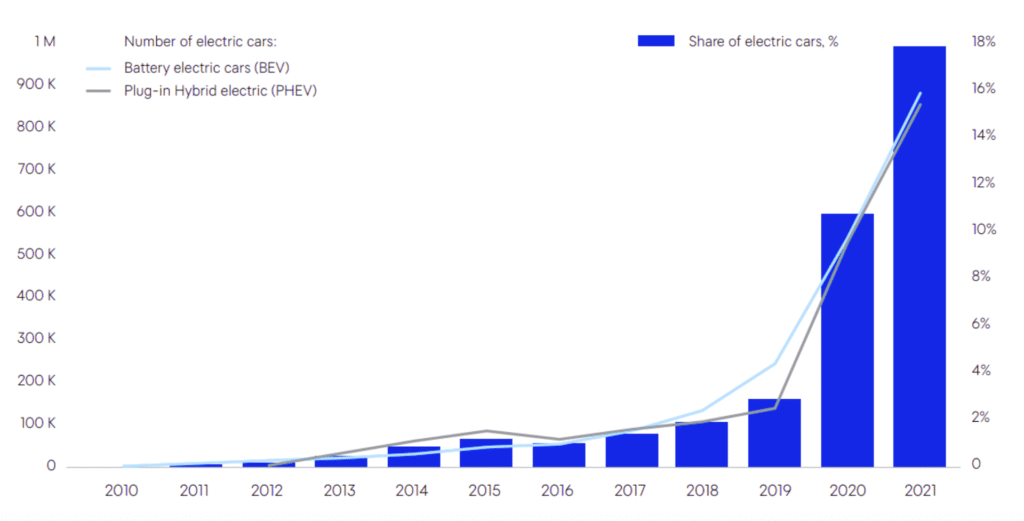
Source: European Environment Agency, 2022
Accelerated EV adoption is driven by both consumer demand and governmental regulations. One key factor in wider adoption in some countries, especially in the Nordics, is financial incentives such as tax reductions or exemptions. Increasingly, more countries are offering incentives for electric mobility. The 27 member states of the EU have raised the stakes by voting to ban sales of new Internal Combustion Engine (ICE) vehicles by 2035. According to McKinsey, EVs will account for 75% of new car sales in Europe by 2030. Recently proposed legislation also targets a 55% reduction in car emissions and a 50% cut in van emissions by 2030.
The rapid increase in EVs will require a massive expansion of Europe’s EV charging infrastructure, as sales are currently outpacing the deployment of charging stations. As of 2021, the EU had approximately 375,000 public charging stations. While there are many more charging points installed at homes, workplaces, and other private locations, McKinsey estimates that to meet future demand, the EU will need at least 3.4 million operational public charging points by 2030. In addition, utility upgrades will be necessary to distribute electricity to this vast number of new charging stations, with estimated costs reaching €240 billion by 2030.
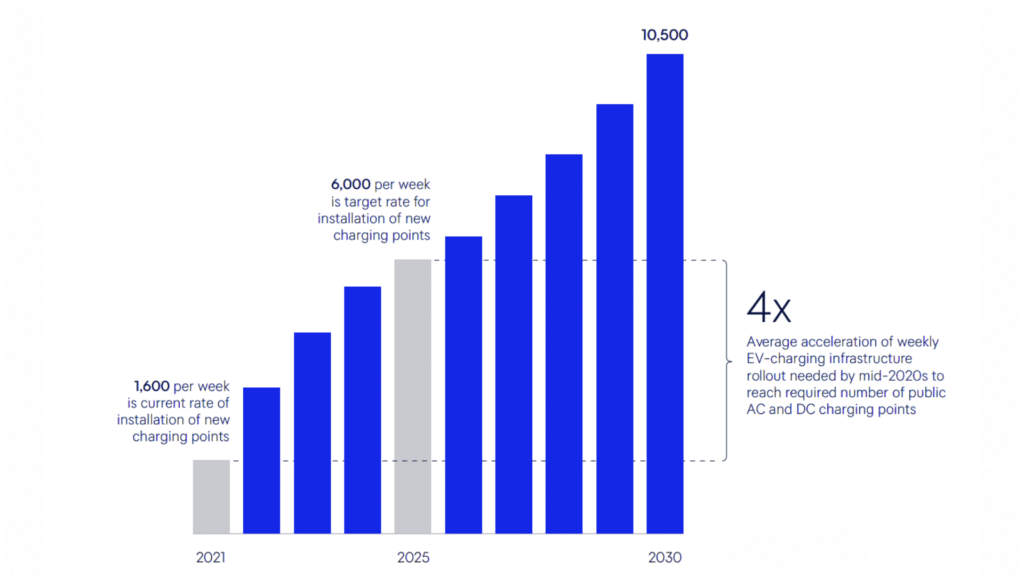
Source: McKinsey, 2022
What this means is that various parts of the ecosystem will encounter several challenges, including the need to scale up both the production and installation of charging stations. Additionally, charging point operators (CPOs) must work closely with utility companies to optimize energy demands.
EV charging sits at the core of the EV ecosystem, with its greatest advantage being that, in theory, an EV can be charged almost anywhere—whether at home, work, destinations like supermarkets or public events, and even along roads and highways during travel. The European market already hosts a large number of CPOs. Some focus solely on charging operations, while others come from related industries such as car manufacturing, utility companies, and even the petroleum sector.
For CPOs, rapid deployment of new charging installations faces real obstacles, including planning restrictions, ease of access, power grid limitations, and, critically, the necessity for resilient and highly secure connectivity. It’s clear that demand is already surpassing supply.
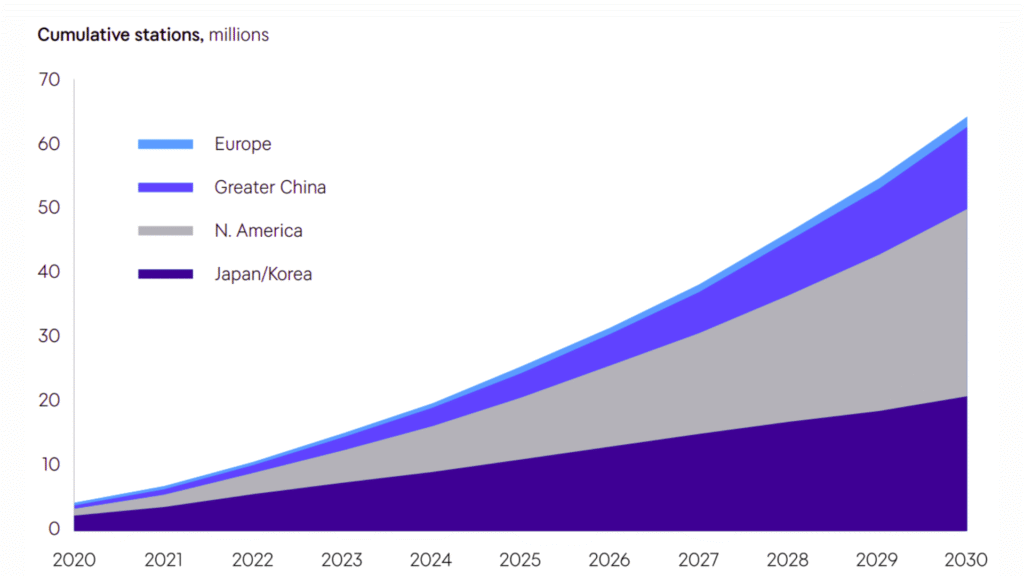
Source: IHS Markit, 2021
Due to convenience and cost-effectiveness, the majority of EV owners most commonly charge their vehicles at home. While this works for individual homeowners, the fact that so many people charge their EV overnight means increased energy demands during the night, which could turn off-peak times into new peak times. And for apartment dwellers, many of whom do not have dedicated parking spaces, the lack of charging capacity at home can be a barrier to adoption.
Workplace EV stations are increasingly available, which can help offset the ‘overnight charging at home’ scenario, as well as the needs of people who live in apartments. An increasing number of charging stations are becoming available in company parking lots, while other commercial areas, such as supermarkets, shopping malls, sports arenas, public car parks, etc. also offer charging opportunities, although in these cases ‘first come, first serve’ remains a challenge, so fast charging or optimized charging will be more suitable.
Essentially, there are a number of options that will go a long way in serving EV charging needs – and ingenuity and innovation will likely be the keys to scaling.
With EVs eventually becoming the primary mode of transportation, installing charging stations in cities and towns and along highways – similar to present-day gas stations – will be essential. These charging setups will require fast charging installations that allow people to charge quickly while on the go. Additionally, ‘charging plazas’ are increasingly being considered. Charging plazas are defined as two or more EV charging stations which are not connected to the grid separately, instead sharing a single connection. One such charging plaza in Bavaria, Germany, currently features 72 charging stations and when completed, will offer 120 Level 2 charging points (up to 60 kW) and 24 DC fast charging points (up to 350 kW). The plaza predicts it will be able to charge up to 4 000 EVs daily using green electricity.

What brings additional worth to this plaza – and what will bring additional worth to others like it – is the added value services, which include a café, shops, offices, conference rooms, outdoor seating areas and even playgrounds. This is an expansion on the ‘fuel retail’ model we currently see, where your average gas station has a shop where you can buy anything from a bottle of water to anti-freeze. Charging plazas have the opportunity to use the extra time it takes to charge an EV to offer customers a host of services, many of which can be tailored to specific customer needs through the use of data.
Stationary charging stations are not going to be enough to meet demand, which means fast in-transit charging stations are going to need to be employed. Luckily they are already happening. One such initiative from Sweden’s Elonroad employs in-road conductive charging strips that allow drivers to charge their EV as they travel. While this is a great solution for cities and highways, it will bring even greater value in rural areas, where charging points may be fewer and farther between. Additionally, at ports and other spaces where trucks, forklifts, and other vehicles are often in service 24/7, the ability to charge ‘as you go’ means the need to take a vehicle out of service to charge it may be reduced or even removed.
The efficiencies of solar panels continue to advance, and the costs are dropping. Parking garages – whether that’s at home, at the office, or at the shopping mall or airport – can be converted into solar-powered charging stations (SPCSs) that work as stand-alone units or that can be connected to the grid. In the short term, SPCSs can be used to ‘top up’ an EV, which will help do away with range anxiety. In the longer term, this could be another solution for rural areas, where charging stations are not as available and where a lack of grid infrastructure in some countries can be a challenge.
The concept is similar to the power banks used for mobile phones, except here energy is stored in large battery banks that are mounted on vehicles that can be moved from place to place. They can be powered with green energies (solar, wind, etc.) or by conventional energy, and they can be tracked by drivers who may need an emergency top up. They can also be placed in areas where charging infrastructure is limited for any number of reasons.
All of these exciting innovations make it clear that a viable EV ecosystem has swiftly emerged – but the big question on everyone’s mind is can the electricity grid handle all the EVs we already have, as well as the many that will be taking to the road as we progress toward an electrified transportation future? In the short term, the answer is yes.
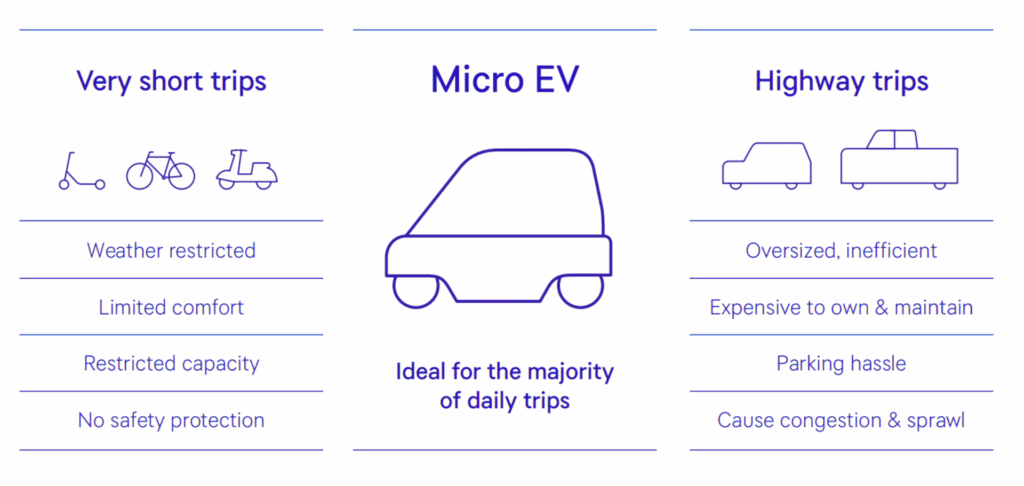
Electrification of transportation and mobility will be one of the key enablers in boosting the transition to greater sustainability and innovation. EVs are eco-friendly and contribute to the reduction of pollution while accelerating the integration of renewable energy sources. But while the growth of EVs can introduce new opportunities, they can also pose a threat to the existing energy system.
EVs in and of themselves do not create a power-demand crisis – what they can do is contribute to hourly peak demand, which can then reshape the electricity load curve. Therefore, if EV charging is not managed smartly and in a controlled way, the current energy system could face an additional burden caused by hourly peak demand in congested zones.
But let’s look at it like this: when people talk about the demands EVs are going to place on the grid, they often picture all these electric vehicles charging at the same time – but the chances of every EV charging at the same time is so small as to be negligible, so clearly the timing of charging is crucial.
The truth is that the electricity grids in most developed nations are well-equipped to handle the current demands from the EV ecosystem, as long as the demand is managed strategically. Distribution systems in areas with high plug-in EV adoption may very well see load increases that add more stress to the system. Putting the focus on strengthening the reliability and resilience of the distribution system will go a long way towards keeping temporary faults from affecting the grid.
The key to preparing for an electrified future is to look at the entirety of the grid and to take a system-wide approach to managing key pressure points as well as build a foundation for a broader charging network.
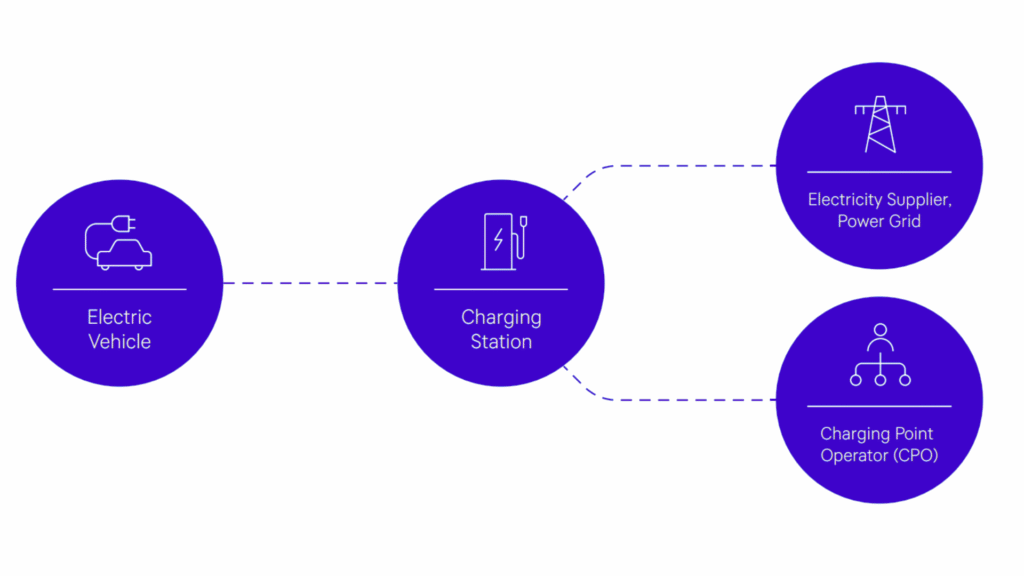
CPOs already use IoT for location finders, handling payments, tracking, etc., but they are also using IoT technology to relay their status to energy companies. Due to fluctuating energy prices, it is essential that payment solutions are also adaptive, adjusting the cost of charging depending on the hour and the load of the grid. Additionally, smart charging technology allows charging speed to be changed, depending on the requirements of both customers and the grid. A connected infrastructure enables communication among EVs, the charge point operators’ management platform, and the power grid system so that energy consumption can be managed and adjusted based on current energy demand. Simply put, smart connected charging promotes the increased penetration of EVs without overly impacting the existing grid infrastructure.
As the EV ecosystem grows, the security vulnerabilities of the different stakeholders can make them attractive targets. There are a number of ways charging stations in particular can be compromised. From exposed user and charger data to a lack of proper authorization keys, the weaknesses show a real need to strengthen security in order to protect drivers, fleet operators, CPOs and everyone in between. Additionally, attacks on the EV ecosystem can put the power grid at risk.
While some regulations relating to the EV ecosystem have been introduced, with more under development, relevant players need to understand their roles and responsibilities in terms of existing applicable regulations (such as GDPR for data protection). But there remains no comprehensive list of guidelines or regulations when it comes to protecting the EV charging ecosystem – while at the same time many industry professionals put security at the top of the list of challenges. Here are a few ways to mitigate risk within the ecosystem:
In the end, the simplest and most effective way to protect the EV ecosystem, no matter where you are in it, is to stay current and make sure that you are working with providers who understand the importance of security – and who can also provide the level of security you want and require.
The makers of electric vehicles have an opportunity to design for sustainability, because while electric vehicles have a positive impact on carbon emissions, some materials – neodymium and dysprosium – are rare metals used to make magnets for EV electric motors. Lithium and cobalt, required for vehicle batteries, are only available in limited regions. Extraction is both expensive and environmentally damaging. There are ways to address these challenges and make them part of the EV model:
Recycle and reuse the rare metals used to make electric vehicles. EV makers should also look at using common, non-virgin materials to enhance sustainability and green mobility. Because the industry is still young, this presents a rare opportunity to introduce circularity early on, making it an integral part of manufacturing processes, which will not just boost social responsibility, but also reuse valuable materials and save money.
Some like to call this ‘the right vehicle for the right journey’. Makers of electric cars should look at other modes of transportation and understand how they compare and align, particularly in urban areas. This is where the concept of the EV ecosystem really shines. Cars are just one mode of electric transportation; we also have e-motorcycles, e-bikes, mini-mobility, e-scooters, electric buses, etc. Ideally, EVs will become ‘mobility as a service’ (MaaS), which will enable end-to-end travel with multiple modes of transport. Different service providers will come together under a single platform for trip planning, scheduling, ticketing, payment, etc.

It’s also interesting to note that delivery companies, such as Sweden’s Budbee, are committed to not just fully electrifying their fleets, they are utilizing excess energy from their solar-powered logistics warehouse to help power that EV fleet, ultimately delivering packages in an environmentally conscious way.
Micro-mobility – also called mini-mobility or urban mobility – is defined as small, lightweight vehicles that typically operate at speeds under 25kph. These include e-bikes, e-scooters, and single-passenger vehicles and are best suited to short trips in an urban environment. Considering that the majority of car trips are under 20km, micro-mobility is ideal for everyday travel. In fact, the World Economic Forum (WEF) says micro-mobility is the future of urban transportation – something we can already see in many cities around Europe and beyond.
Charging stations have long since evolved from non-connected hardware devices to being fully connected and always on. But with so many stakeholders – hardware providers, drivers, payment systems, apps, city planners, homeowners, etc. – coupled with the pressure to expand the charging network, cellular IoT connectivity is crucial in managing the complex EV ecosystem – with all stakeholders benefiting.
Look at it like this: the EV ecosystem is a system of events and communications. Things like public charging stations or charging plazas need to be maintained and monitored remotely. Drivers need to be connected via apps, location services need to work, and payments need to be processed. And of course, there needs to be communication with the grid to ensure that the all-important electric juice keeps on flowing.
Charging points need to be reliable, secure, convenient, and fast. They need to monitor electricity, usage, maintenance, and have built-in security in order to have reliability and enhanced performance. Charging apps and navigation systems must be able to communicate reliable data in real time so that drivers can locate the nearest accessible station, filter compatible charging systems, calculate battery range, display prices per kilowatt hour or minute, and perhaps most importantly, pay securely.
Ultimately, EV charging requires a complete real-time infrastructure for communications between the CPO, the app and navigation systems, and the driver. In order for this to happen, EV charging network providers must:
The type of SIM you choose is also crucial: according to Berg Insight, extreme weather conditions means choosing a premium industrial SIM card is essential for the longevity of your project. Gateways, routers, and modems are often installed to manage the connectivity of single or multiple stations, and devices around these stations include CCTV cameras. While you can buy the devices from any hardware supplier, being able to manage the connectivity of your solution is a strategic choice.
And remember, not every electric vehicle is a car. Boats, motorcycles, scooters, bikes, mini-mobility, etc. also need to find charge points and while bikes and scooters can likely charge easily at home or work, boats, motorcycles and even mini-mobility vehicles like e-cargo bikes will need to be connected to a more comprehensive system.
Basically, there is no EV ecosystem without IoT. Cellular IoT connectivity is the glue that holds the whole ecosystem together – but the market is still fragmented and many CPOs are installing stations in any number of different countries. That means that finding a connectivity provider who can adjust to your growth and expansion needs is a decision that needs to be made sooner, rather than later.
The makers of electric vehicles have an opportunity to design for sustainability,
While cellular IoT connectivity is the key to the continued evolution of the EV ecosystem, there can be challenges when managing that connectivity, which could impact both customer experience and profitability.
Managing cellular IoT at large scale can be overwhelming, so having the right Connectivity Management Platform (CMP) means you can scale faster, operate smarter, and better secure your solution. Unlike cellular IoT platforms that simply connect your EV solution to the network, a sophisticated CMP also helps you scale quickly and increase profitability by delivering outstanding customer experiences while also reducing costs and automating more of your business. So, whether you’re just starting out or are already well on the road to scaling, choosing the right CMP will accelerate your IoT journey from when you deploy your first sensors to operating at scale.
The EV ecosystem is still evolving and having an ecosystem mindset will ensure that players across the value chain will think beyond product features, instead focusing on what customers want and how they will use the different business offerings and service providers.
As the market develops, some companies will focus on particular areas of the ecosystem, such as charging stations or payment systems, while others will work across two or more areas. What is clear is that everyone, from EV makers to those providing value-added services, will need to come together. How things evolve will depend on a number of things, including customer need, regulatory shifts, and perhaps most importantly, innovation that addresses and removes some of the bigger challenges. One thing is certain: the EV transportation revolution is here.
If you would like to learn more about how IoT can enable your business, please get in touch.